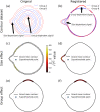Landmark-free, parametric hypothesis tests regarding two-dimensional contour shapes using coherent point drift registration and statistical parametric mapping
- PMID: 34084938
- PMCID: PMC8157043
- DOI: 10.7717/peerj-cs.542
Landmark-free, parametric hypothesis tests regarding two-dimensional contour shapes using coherent point drift registration and statistical parametric mapping
Abstract
This paper proposes a computational framework for automated, landmark-free hypothesis testing of 2D contour shapes (i.e., shape outlines), and implements one realization of that framework. The proposed framework consists of point set registration, point correspondence determination, and parametric full-shape hypothesis testing. The results are calculated quickly (<2 s), yield morphologically rich detail in an easy-to-understand visualization, and are complimented by parametrically (or nonparametrically) calculated probability values. These probability values represent the likelihood that, in the absence of a true shape effect, smooth, random Gaussian shape changes would yield an effect as large as the observed one. This proposed framework nevertheless possesses a number of limitations, including sensitivity to algorithm parameters. As a number of algorithms and algorithm parameters could be substituted at each stage in the proposed data processing chain, sensitivity analysis would be necessary for robust statistical conclusions. In this paper, the proposed technique is applied to nine public datasets using a two-sample design, and an ANCOVA design is then applied to a synthetic dataset to demonstrate how the proposed method generalizes to the family of classical hypothesis tests. Extension to the analysis of 3D shapes is discussed.
Keywords: 2D shape analysis; Classical hypothesis testing; Morphology; Morphometrics; Spatial registration; Statistical analysis.
©2021 Pataky et al.
Conflict of interest statement
Philip G. Cox was an Academic Editor for PeerJ.
Figures











References
-
- Adams DC, Otárola-Castillo E. Geomorph: an R package for the collection and analysis of geometric morphometric shape data. Methods in Ecology and Evolution. 2013;4(4):393–399. doi: 10.1111/2041-210X.12035. - DOI
-
- Adams DC, Rohlf FJ, Slice DE. Geometric morphometrics: ten years of progress following the ‘revolution’. Italian Journal of Zoology. 2004;71(1):5–16. doi: 10.1080/11250000409356545. - DOI
-
- Adams DC, Rohlf FJ, Slice DE. A field comes of age: geometric morphometrics in the 21st century. Hystrix. 2013;24(1):7.
-
- Adler RJ, Taylor JE. Random fields and geometry. Springer-Verlag; New York: 2007.
-
- Anaconda Anaconda software distribution version 3-6.10. 2020. https://anaconda.com https://anaconda.com
LinkOut - more resources
Full Text Sources
Research Materials
